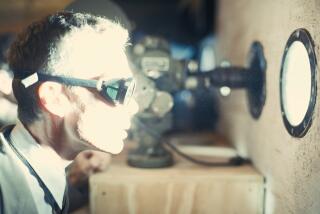An Elite NEST to Protect Against the Ultimate Terrorist Weapon
- Share via
LAS VEGAS — On a remote corner of Nellis Air Force Base, in a sprawling compound ringed by barbed wire fence, scientists who once prepped for nuclear war are now girding for a different battle--nuclear terrorism.
Members of the elite Nuclear Emergency Search Team, the nation’s nuclear fire department, once used the word “if” when discussing the ugly scenario of terrorists using a nuclear device for political or financial blackmail.
Now they say “when.”
Hundreds of members of NEST--ranging from the architects of the nation’s nuclear arsenal to the engineers who once tested the devices--rehearse regularly for the day they hope will never come.
“Our job would be to find the nuclear device or materials, determine what it is, render it safe, then get rid of it,” said one NEST operative during a recent rare tour of the team’s $75 million facilities. He requested anonymity for security reasons.
With the breakup of the Soviet Union there is growing concern over remnants of Russia’s nuclear arsenal falling into terrorist hands. And with rogue nations like Iraq, Iran, Libya and North Korea on the nuclear weapons threshold, the problem is exacerbated.
NEST operatives believe it is just a matter of time.
“That’s the way the [nuclear] community is approaching the problem,” said John Weidner, NEST program manager. “It’s not a question of ‘if,’ but ‘when.’ ”
The elite team has responded to dozens of threats since it was formed in 1974--stolen plutonium from a Wilmington, N.C., plant, recovery of radioactive debris from a fallen Soviet satellite, radioactive monitoring in the Three Mile Island accident and nuclear extortion attempts against Union Oil Co. in Los Angeles and Harrah’s Hotel-Casino in Reno, Nev.
Has the team ever come face-to-face with a terrorist nuclear device?
“We have had threats. We have responded. How we have resolved them I won’t say,” Weidner says cryptically.
The Oklahoma City bombing, the World Trade Center attack and the gassing of a Tokyo subway are frightening proof that terrorists have the capability and the fervor to carry out assaults without regard to the consequences, he said.
“The real defining event was the collapse of the Soviet Union,” said Weidner. “It presents more opportunities for nuclear weapons and materials to fall into the wrong hands.”
NEST was formed when federal officials, responding to a nuclear threat against the city of Boston, botched the effort. Luggage and vital equipment ended up in one city, personnel in another.
Fortunately for Boston, the scare was a hoax. But the bungling prompted then-President Ford to order the Atomic Energy Commission, the DOE’s predecessor, to devise a plan that could cope with future terrorist threats.
Those forming the team included top scientists from the nation’s nuclear weapons laboratories at Lawrence Livermore near San Francisco and at Los Alamos, N.M.
Terrorist threats are evaluated by NEST personnel at the Energy Department’s Emergency Response Program in Germantown, Md., who work with the FBI.
If the threat is deemed real, teams ranging from a dozen people to a contingent in the hundreds fan out from Nellis and the two weapons labs. Equipment that sits containerized and ready for shipment at Nellis is loaded onto wide-bodied aircraft.
Included are radiation-sensing planes and helicopters, nondescript vans packed with high-tech equipment, communications satellites, generators, secure phone systems and attache cases bearing elaborate sensing gear.
“This sensing equipment can be put into any type of carrier to fit into any environment we want to search, from the beach to shopping malls, airports, crowded streets and buildings,” said a NEST member, pointing out two tan attaches bearing high-tech monitors.
The sensing gear talks to team members via wireless earpieces, allowing them to walk undetected in crowded environments, seeking out nuclear weapons and materials. Vans disguised as personal or commercial vehicles roam nearby to pick up signals of radiation sources.
Most team members have full-time jobs with DOE and the weapons labs. Only a handful work for NEST full time.
Members are on call around the clock, and are known to scramble on simulated exercises at times such as 3 a.m. on a Sunday.
Team members carry pagers, and some “are on very rapid response strings,” Weidner said.
Tracking systems are monitored at NEST facilities here, and some weapons scientists are assigned to remain at their labs, fixed at their computers to research a device and determine how to render it harmless.
“We go back to the nuclear weapons people who work with the blueprints on a regular basis. They know the ins and outs of how nuclear weapons function,” Weidner said. “Our real hope is that once we find it, we can disarm it. We plan against an entire range of scenarios.”
NEST scientists can cope with Soviet devices because “the physics of [U.S. and Soviet] nuclear weapons are the same,” said another NEST operative.
How good is the team?
In the case of the Soviet satellite, NEST monitoring aircraft swept an area of Canada 600 miles long and 600 miles wide, detecting particles of radioactive debris as small as a grain of salt, the DOE said.
NEST will deploy anywhere in the world, if invited by a foreign country through the U.S. State Department.
NEST members hone their skills with realistic exercises such as Mirage Gold, a training scenario in New Orleans in 1994 in which operatives tracked down a radiation source in an aging two-story house.
“I must make sure our resources are ready if one of these things pops up where it’s not supposed to be,” said Weidner. “The magnitude of the consequences is so grave, we must be prepared.”
More to Read
Sign up for Essential California
The most important California stories and recommendations in your inbox every morning.
You may occasionally receive promotional content from the Los Angeles Times.










